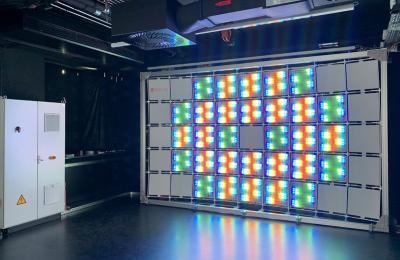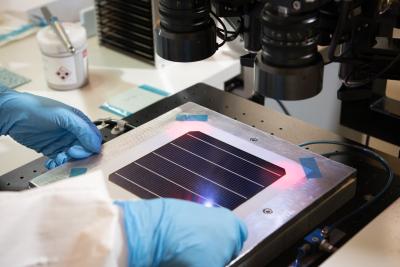"Katana" project to establish reliable measuring system for tandem solar cells
To pave the way for the industrial implementation of efficient perovskite-silicon PV modules, a reliable measuring system for tandem solar cells and modules must be established. Only then can objective comparisons between different cells and modules take place. In contrast to conventional silicon PV modules, however, the calibration is considerably more challenging.
A project consortium, led by the Fraunhofer Institute for Solar Energy Systems ISE, is therefore developing methods for characterizing perovskite-based tandem modules in the "Katana" project, funded by the German Federal Ministry for Economic Affairs and Climate BMWK. The solar simulator specially built for this purpose by the company Wavelabs Solar Metrology Systems GmbH is now in use in the CalLab PV Modules of the research institute.
New project will utilize quantum computing to advance perovskite PV materials
A UK-based quantum software company called Phasecraft will lead a project modelling new perovskite-silicon materials for solar photovoltaics. The project, in collaboration with Oxford PV and scientists at University College London (UCL), is aimed to support the development of quantum computing to simulate “currently intractable problems” in PV materials modelling, according to a recent statement.
Not many details were given regarding the new project, which received an award from UK Research and Innovation’s Commercializing Quantum Technologies Challenge. It was, however, said that it will set out to develop a modelling capability that is tailored to the real-world needs of the PV industry.
Researchers examine the environmental performance of perovskite-on-silicon tandem solar cells
A team of scientists from Technische Universität Berlin, Oxford PV Germany, German Philipps-Universität Marburg, Helmholtz Zentrum Berlin (HZB) and Oxford PV UK has, for the first time, assessed the environmental performance of industrially produced perovskite-on-silicon PV modules. Understanding the environmental impact of solar PV modules across their entire lifecycle is essential for the design of more sustainable solar energy systems. However, lifecycle assessment of perovskite-on-silicon PV modules has so far relied heavily on data from laboratory and test facilities rather than manufacturers.
The researchers conducted a comprehensive lifecycle assessment of a perovskite-on-silicon module across a number of categories including global warming potential, water consumption, human and marine toxicity, and metals usage. They assessed the materials and energy input for a module’s ‘cradle to gate’ lifecycle, covering all materials and energy input for wafer production, manufacture of the perovskite cell, and module production. The researchers then weighed up the environmental impact of the tandem module against the electricity generated over its lifetime.
When will perovskite solar panels hit the market?
Perovskite solar panels have been under intensive R&D, and it seems as if commercial production is right around the corner. Some pilot-scale production lines are already functional, and companies are now ramping up production of perovskite panels, using various technologies.

UK-based Oxford PV, for example, recently announced that it has completed the build-out of its 100 MW manufacturing site in Germany, and it is on track to start full production in 2022. China's Microquanta Semiconductor perovskite panel factory is reportedly also nearing production (which should have started late 2020, but updates have not been available since), and another China-based company, GCL, has raised around $15 million USD to expand its pilot-scale production factory to mass production (100 MW).
Oxford PV explains the benefits of pairing perovskites with silicon
Scientists from Oxford PV have recently published a study describing how pairing metal halide perovskites with conventional silicon leads to a more powerful solar cell that overcomes the 26% practical efficiency limit of using silicon cells alone.
'We identified perovskites as the perfect partner for a tandem system with silicon,' commented author Laura Miranda Pérez.
Pagination
- Previous page
- Page 3
- Next page





